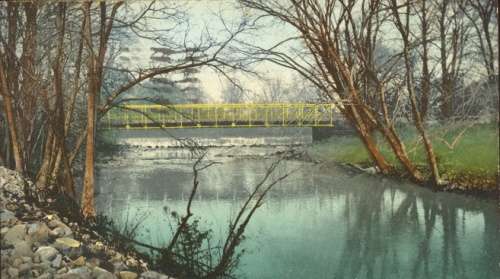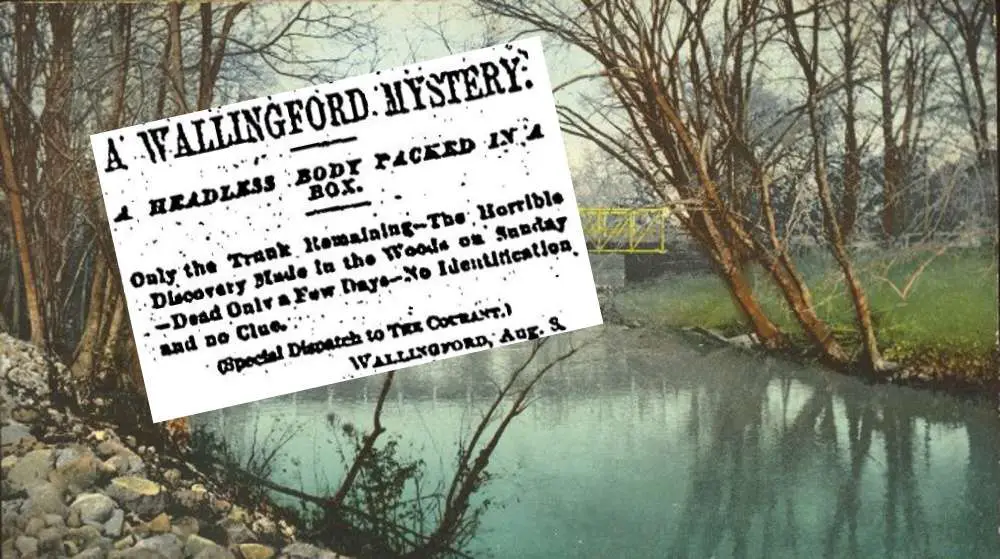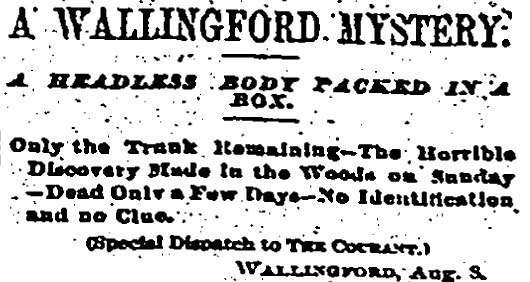The Wallingford shoebox murder was discovered on the Sunday morning of Aug. 8, 1886. Three young men rambling through farm country happened to stumble across it.
Edward and Joseph Terrill and a friend were walking along an old logging road about three miles from the town center. Then Edward’s dog approached a wooden crate under a tangle of huckleberry bushes. Edward Terrill “thought nothing strange until his dog approached the box and acted in a strange manner, sniffing about the box and whining,” the Hartford Courant reported.
The lettering on the outside of the 30” by 12” wooden box said its contents were a half-dozen pairs of ‘machine sewed, fine stitched’ men’s shoes. But it gave off a peculiar smell. The young men pried it open and discovered a bloody dismembered male torso. Someone had wrapped it in straw and tar paper.
A medical examiner could only determine the body belonged to a healthy man, 30 to 40 years old. He had died five to 10 days earlier. Further examination found in his stomach a large quantity of arsenic – which had also caused the sensational murder of beautiful Jennie Cramer five years earlier.
Head Hunt
At first people thought the body belonged to Albert Cooley, an old soldier who had recently taken a $1,500 pension from a local slaughterhouse and then went missing. But then Cooley turned up alive.
Another theory held that an arsonist who had set a number of fires recently had turned on his accomplice. A third blamed an unidentified tramp who hung around the train station.
By September the victim’s identity was still unknown, though the woods had been searched and police had combed through files and pored over missing persons reports.
Local butchers fell under suspicion. When one butcher’s employee mysteriously disappeared, police thought he might have been the victim – until they found him alive and healthy.
On Sept. 26, a farmer found the victims’ arms and legs near the spot where the young men found the box. The had, though, never turned up. Rumors circulated that the head had been found in a well, but that proved false.

Wallingford, the Quinnipiac River
Wallingford Shoebox Traced
The box itself was traced to a Fall River shoe factory, which had sent it to a shoe dealer in Chicago. The dealer had thrown it behind his store and several months later sold it to a man who disappeared. That sparked more rumors that the victim was somehow connected to the Haymarket Riots.
A local prostitute, Mabel Gage, told police she knew all about the Wallingford Shoebox Murder. Two years later she committed suicide.
A constable claimed he knew the murderer but would take the knowledge to his grave. He did.
No one ever solved the Wallingford Shoebox Murder. The old logging road where the box was found is still known as Shoebox Road.
Read more about the Wallingford Shoebox Murder in True Crime: Connecticut: The State’s Most Notorious Criminal Cases by Brian Ethier. This story was updated in 2023.


8 comments
[…] legal representation at his first trial, but that was not unique to his case. The rules governing who was entitled to an appeal based on new testimony were not firm. Still, the myth of the dangerous drunken Indian was well […]
[…] Dunbar was born June 3, 1746, in Wallingford, Conn., the second of 16 children. A Congregationalist, he married Phebe Jerome. The couple had seven […]
[…] Mercy Tuttle, the youngest daughter of the clan, had married Samuel Brown in 1667 at age 17. The couple had several children, including a son, Samuel. They lived in Wallingford. […]
[…] patriots placed him under guard at Wallingford and then Middletown. However, the stubborn governor-in-exile refused to submit to his captors. He […]
Does the evidence still remain? If there’s any DNA, they can even reproduce a face.
[…] Perfectionists set up a satellite community in Wallingford, Conn., where they made matchboxes, and in Brooklyn, N.Y., where they made traveling bags. Two other […]
[…] the latter half of the century, two notable examples were Wallingford and Shelton. Wallingford, incorporated in 1853, became known for Britannia ware and […]
[…] went to boarding school at Rosemary Hall (now Choate Rosemary Hall) in Wallingford, Conn., graduating at […]
Comments are closed.